
The Spandau Citadel is a fortress in Berlin, Germany, one of the best-preserved Renaissance military structures of Europe. Built from 1559–94 atop a medieval fort on an island near the meeting of the Havel and the Spree, it was designed to protect the town of Spandau, which is now part of Berlin. In recent years it has been used as a museum and has become a popular tourist spot. Furthermore, the inner courtyard of the Citadel has served as an open air concert venue in the summertime since 2005.
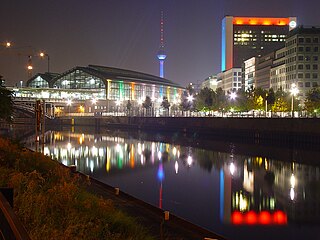
The Berlin S-Bahn is a rapid transit railway system in and around Berlin, the capital city of Germany. It has been in operation under this name since December 1930, having been previously called the special tariff area Berliner Stadt-, Ring- und Vorortbahnen. It complements the Berlin U-Bahn and is the link to many outer-Berlin areas, such as Berlin Brandenburg Airport. As such, the Berlin S-Bahn blends elements of a commuter rail service and a rapid transit system.
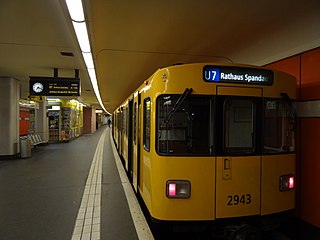
The U7 is a rail line on the Berlin U-Bahn. It runs completely underground for a length of 31.8 kilometres (19.8 mi) through 40 stations and connects Spandau, via Neukölln, to Gropiusstadt and Rudow. The U7 was originally the south-eastern branch of the Nord-Süd-Bahn (U6) that ran between the branching point at Belle-Alliance-Straße (Mehringdamm) and Grenzallee; however, in the 1960s, this stretch was separated from the rest of the line and extended at each end to form a new line.
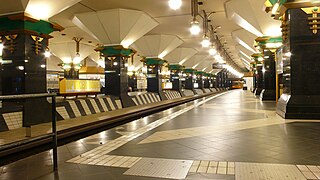
Rathaus Spandau is the western terminus of Berlin U-Bahn line U7. It was opened on 1 October 1984 with the line's extension from Rohrdamm to Rathaus Spandau. The station takes its name from the nearby Rathaus Spandau, the historic city hall of Spandau.

Altstadt Spandau is a station in the Spandau district of Berlin, on that city's U-Bahn line U7. It takes its name from the Altstadt Spandau, the historic central area of the former independent city of Spandau.

Zitadelle is a station on the Berlin U-Bahn line U7. It was opened on 1 October 1984 with the line's extension from Rohrdamm to Rathaus Spandau. Its name means "Citadel" in English and it was named for the historic Spandau Citadel. Unlike most U-Bahn stations, Zitadelle has side platforms. The station's interiors were also designed to resemble the citadel's style.
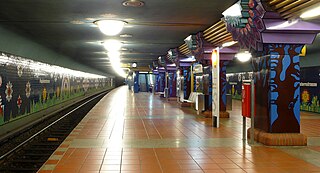
Paulsternstraße is a station on the Berlin U-Bahn line U7. It was opened on 1 October 1984, with the line's extension from Rohrdamm to Rathaus Spandau. Its name means "Paul Stern Street" in English, Paul Stern having been the name of a pub owner after whom a Spandau neighbourhood was named. The station's interiors are notable for the large and colorful mosaics which decorate almost all walls. All signs spell "Paulsternstrasse".

Rohrdamm is a station on the Berlin U-Bahn line U7 in the Siemensstadt district.

Siemensdamm is a station on the Berlin U-Bahn line U7, located in the Spandau district. It was opened on 1 October 1980 with the line's extension from Richard-Wagner-Platz to Rohrdamm. The station is named after an arterial street, which itself is named after Werner von Siemens. The company he founded, Siemens AG, has many facilities in the station's surroundings.
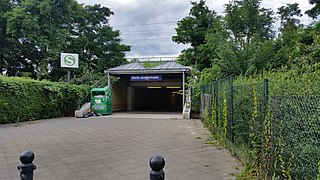
Berlin Jungfernheide is a railway station located at Charlottenburg-Nord, in the Charlottenburg-Wilmersdorf district of Berlin, served by the S-Bahn lines S41 and S42, the U-Bahn line U7 and Regional-Express trains of the Deutsche Bahn. Its name literally translates into "maidens' heathland"; it was named after the Jungfernheide, a former large forest in the proximity of this station.

Ruhleben is a Berlin U-Bahn station, the western terminus of line U2. Named after the adjacent Ruhleben neighbourhood, it is located in the Westend district close to the border with Spandau.

Haselhorst is a locality in the borough of Spandau in Berlin. It is located between Siemensstadt and the Old Town of Spandau and is separated from the Hakenfelde locality by the River Havel.

Gneisenaustraße is a station on the U7 in Berlin, Germany.
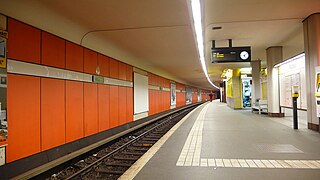
Rudow is a Berlin U-Bahn station located on the U7 line. There is a bus link to Berlin Schönefeld Airport, served by the line 171 and the express bus X7. Since 2015, the station has been under extended refurbishment to provide a better interchange between buses serving Brandenburg Airport/BER and the trains.

Berlin-Spandau station is a Deutsche Bahn station in the Berlin district of Spandau on the south-western edge of the old town of Spandau. The railway junction station is one of the 80 stations classified by Deutsche Bahn as a category 2 station. It has the longest train shed in Germany.
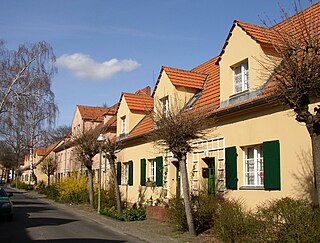
Siemensstadt is a locality (Ortsteil) of Berlin in the district (Bezirk) of Spandau.

Spandau is a locality (Ortsteil) of Berlin in the homonymous borough (Bezirk) of Spandau. The historic city is situated, for the most part, on the western banks of the Havel river. As of 2020 the estimated population of Spandau was 39,653.

Bus transport is the oldest public transport service in Berlin, the capital city of Germany, having been introduced in 1846. Since 1929, services have been operated by the Berlin Transport Company, although during the Cold War-era division of the city they operated in West Berlin only. In East Berlin the public transport agency split off from the BVG and rebranded as BVB, operating the busses in the soviet sector of Berlin.

Hakenfelde is a German locality (Ortsteil) of Berlin in the borough (Bezirk) of Spandau.

The Electric Tramway Spandau-Nonnendamm GmbH (SpN) – colloquially known as Nonnendammbahn – was a tramway company that operated between 1909 and 1914, originating from a tram line established by Siemens & Halske in 1908. Three months after its founding, the then-independent city of Spandau acquired all shares in the railway, and its operations were taken over by the Municipal Tramway of Spandau the following year. With the deletion of Nonnendammbahn from the commercial register in 1914, it was fully integrated into the Spandau tramway.





















